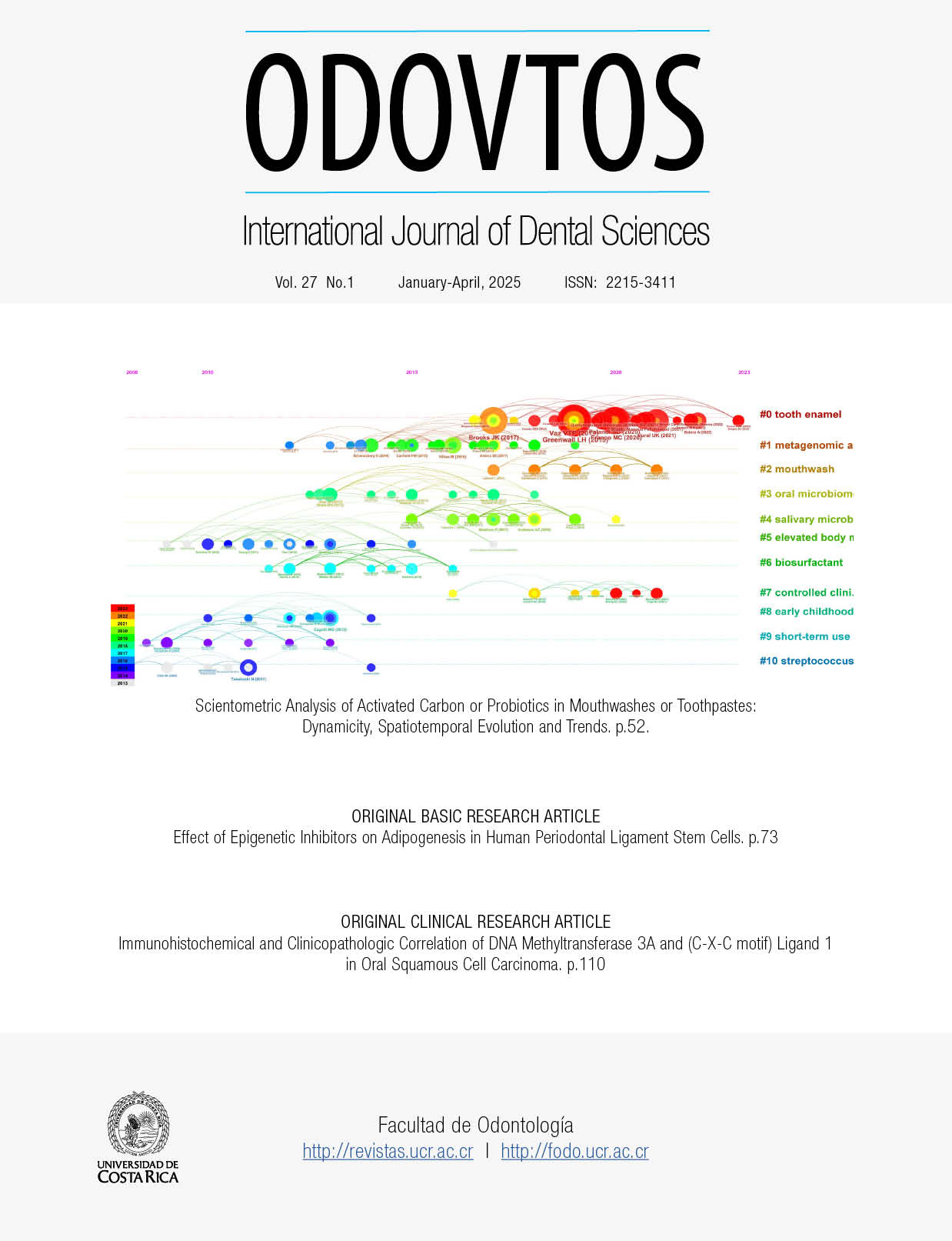Abstract
Histone H3 lysine 9 acetylation is a crucial epigenetic mark in mesenchymal stem cell differentiation processes like adipogenesis. This study aimed to evaluate the effect of epigenetic inhibitors on adipogenesis in human periodontal ligament stem cells, using histone deacetylase inhibitors such as valproic acid and trichostatin A. The cells were treated independently with 8 mM valproic acid and 100 nM trichostatin A for 72 hours to inhibit class I histone deacetylases. Subsequently, the cells underwent adipogenic induction for 28 days. Morphology and intracellular lipid deposition were analyzed using Oil-Red oil staining. Protein extracts were prepared on days 0 and 28 to analyze histone H3 lysine 9 acetylation levels via Western blot. Our results demonstrated that cells treated with either VPA or TSA showed, on average, a 1.275-fold increase in lipid deposition during the adipogenic process, with no significant differences between the treatments compared to the control group. Further, by day 28, histone H3 lysine 9 acetylation levels were 1.43 times higher in cells treated with valproic acid and 2.52 times higher in those treated with trichostatin A.These findings suggest that the inhibitors could have differential effects on chromatin remodeling in different regions by increasing acetylation, contributing indistinctly to lipid deposition due to the greater expression of genes associated with the adipogenic phenotype.
References
González-Casanova J.E., Pertuz-Cruz S.L., Caicedo-Ortega N.H., Rojas-Gomez D.M. Adipogenesis Regulation and Endocrine Disruptors: Emerging Insights in Obesity. Vol. 2020, BioMed Research International. 2020.
Rodas-Junco B.A., Canul-Chan M., Rojas-Herrera R.A., De-la-Peña C., Nic-Can G.I. Stem cells from dental pulp: What epigenetics can do with your tooth. Front Physiol. 2017; 8: 899.
Rajabzadeh N., Fathi E., Farahzadi R. Stem cell-based regenerative medicine. Stem Cell Investig. 2019; 6 (July).
Ozkul Y., Galderisi U. The Impact of Epigenetics on Mesenchymal Stem Cell Biology. Vol. 231, Journal of Cellular Physiology. 2016. p. 2393-401.
Wu H., Yi E.S. Epigenetic regulation of stem cell differentiation. Vol. 59, Pediatric Research. 2006.
Shukla V., Vaissière T., Herceg Z. Histone acetylation and chromatin signature in stem cell identity and cancer. Vol. 637, Mutation Research - Fundamental and Molecular Mechanisms of Mutagenesis. 2008. p. 1-15.
Lawlor L., Yang X.B. Harnessing the HDAC-histone deacetylase enzymes, inhibitors and how these can be utilised in tissue engineering. Vol. 11, International Journal of Oral Science. 2019.
Lee H., Lee J.Y., Ha D.H., Jeong J.H., Park J.B. Effects of valproic acid on morphology, proliferation, and differentiation of mesenchymal stem cells derived from human gingival tissue. Implant Dent. 2018; 27 (1).
Jang S., Hwang J., Jeong H.S. The Role of Histone Acetylation in Mesenchymal Stem Cell Differentiation. Chonnam Med J. 2022; 58 (1).
Sixto-López Y., Bello M., Correa-Basurto J. Exploring the inhibitory activity of valproic acid against the HDAC family using an MMGBSA approach. J Comput Aided Mol Des. 2020; 34 (8).
Zhang Y., Ying J.B., Hong J.J., Li F.C., Fu T.T., Yang F.Y., et al. How Does Chirality Determine the Selective Inhibition of Histone Deacetylase 6? A Lesson from Trichostatin A Enantiomers Based on Molecular Dynamics. ACS Chem Neurosci. 2019; 10 (5).
Um S., Lee H., Zhang Q., Kim H.Y., Lee J.H., Seo B.M. Valproic Acid Modulates the Multipotency in Periodontal Ligament Stem Cells via p53-Mediated Cell Cycle. Tissue Eng Regen Med. 2017; 14 (2).
Gu S., Liang J., Wang J., Liu B. Histone acetylation regulates osteodifferentiation of human dental pulp stem cells via DSPP. Front Biosci (Landmark Ed). 2013; 18.
La Noce M., Mele L., Laino L., Iolascon G., Pieretti G., Papaccio G., et al. Cytoplasmic interactions between the Glucocorticoid receptor and HDAC2 regulate Osteocalcin expression in VPA-Treated MSCs. Cells. 2019; 8 (3).
Catalioto R.M., Maggi C.A., Giuliani S. Chemically distinct HDAC inhibitors prevent adipose conversion of subcutaneous human white preadipocytes at an early stage of the differentiation program. Exp Cell Res. 2009; 315 (19).
Lee S., Park J.R., Seo M.S., Roh K.H., Park S.B., Hwang J.W., et al. Histone deacetylase inhibitors decrease proliferation potential and multilineage differentiation capability of human mesenchymal stem cells. Cell Prolif. 2009; 42 (6).
Hezroni H., Tzchori I., Davidi A., Mattout A., Biran A., Nissim-Rafinia M., et al. H3K9 histone acetylation predicts pluripotency and reprogramming capacity of ES cells. Nucleus. 2011; 2 (4): 300-9.
Qiao Y., Wang R., Yang X., Tang K., Jing N. Dual roles of histone H3 lysine 9 acetylation in human embryonic stem cell pluripotency and neural differentiation. Journal of Biological Chemistry. 2015; 290 (4): 2508-20.

This work is licensed under a Creative Commons Attribution-NonCommercial-ShareAlike 4.0 International License.
Copyright (c) 2024 Julio A. Montero-Del-Toro, Angelica A. Serralta-Interian, Geovanny I. Nic-Can, Rafael Rojas-Herrera, Leydi M. Carrillo-Cocom, Beatriz A. Rodas-Junco

